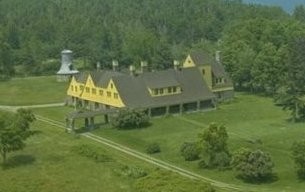 |
 |
|
|
|
|

10 November 2004
A Crumbling Remnant
of the Gilded Age
| |

Sir William Van Horne's
Covenhoven estate on Minister's Island, New Brunswick.
|
Minister's Island -
A short drive across the ocean floor when the Bay of Fundy is at low tide takes visitors to one of
Canada's unique and most overlooked historical treasures. Minister's Island near the seaside town of
St. Andrews in southwestern New Brunswick is home to the remarkable summer estate of Sir William Van
Horne, the driving force behind the construction of Canada's national railway in the late 1800s.
The sprawling estate, called Covenhoven, is one of Canada's few vestiges of the Gilded Age, a time
when those made rich by the booming industrial economy of the late 1800s and early 1900s built
elaborate homes and showy retreats.
But while Covenhoven dates from the Gilded Age, it is rapidly falling victim to the age of tight
budgets, and its future is far from certain.
"The province of New Brunswick has owned the island for some time, but has never had the
resources to do what one might like to see done, and it still doesn't," says Wayne Burley,
director of New Brunswick's Heritage Department.
Even though the 50-room Van Horne mansion is bare of most of its original furnishings
and a number of the old buildings have disappeared, there is still much to see and experience on a
tour of the island estate.
Just getting there is a thrill.
It can be reached only by driving across a naturally occurring gravel bar that is exposed at low
tide. The Bay of Fundy has among the world's highest tides, and visitors to the island have to be
extremely careful that they aren't caught when the fast-moving tide rushes in. In
October, a young man lost his life when he and a friend tried to beat the tide across the
kilometre-long bar. After their vehicle got stuck, the friend managed to swim to shore,
but the young man didn't make it. His body was found two weeks later.
Burley says access to Minister's Island is an issue for any future plans.
There are about 7,000 visitors a year to the island, he says, but he believes many more people would
come if the island could be reached at any time.
Once there, driving across the 200-hectare island is fascinating.
The first building that comes into view is an old Cape Cod house dating from the late 1700s that
belonged to the church minister who gave the island its name.
Towering behind the house is the Van Horne livestock barn, one the largest barns in Canada, where
the railway magnate kept horses and rare breeds of cattle.
Even when Van Horne was living in his Montreal home, fresh milk, butter, fruits and vegetables would
be sent by rail from Minister's Island for use the next day.
Among the many changes Van Horne would not be pleased to see today is the disappearance of the
railway from much of Atlantic Canada, including the St. Andrews area.
Driving on from the barn, the Van Horne mansion comes into view, along with a large windmill that
ensured the home always had lots of running water.
New Brunswick tour guide Marie Hanson says Van Horne and his family built the home, which looks a bit
like a train station, in the 1890s. The 50-room mansion includes at least 17 bedrooms,
11 bathrooms and 11 fireplaces. "Everything is on a grand scale," Hanson says.
Although the furniture in the home was auctioned off in the 1970s by a previous private owner,
photographs of the original interior and exterior views give visitors an idea of the luxurious nature
of the estate.
And while Minister's Island is both a national and provincial historic site, investment in the estate
has been minimal. There has been basic maintenance, but in the mansion chunks of ceiling are falling
down, paint is peeling and walls are deteriorating.
A recently incorporated community group in St. Andrews is working with the province to come up with
a plan for the island's future. Burley says the group will be looking for partners to invest in the
estate and probably will undertake fundraising activities.
But the future of Minister's Island, summer home of the man who made Canada's national dream a
reality, is very much in doubt.
|
|
|